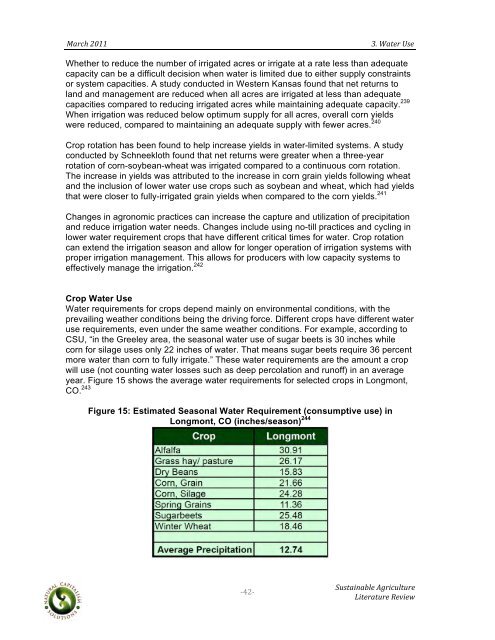Sustainable Agriculture Literature Review - Boulder County
Sustainable Agriculture Literature Review - Boulder County
Sustainable Agriculture Literature Review - Boulder County
You also want an ePaper? Increase the reach of your titles
YUMPU automatically turns print PDFs into web optimized ePapers that Google loves.
! !!<br />
"#$%&!'())!! !!!!!!!!!!!!!!!!!!!!!!!!!!!!!!!!!!!!!!!!!!!!!!!!!!!!!!!!!!!!!!!!!!!!!!!!!?=!@#-2$!A,2!<br />
Whether to reduce the number of irrigated acres or irrigate at a rate less than adequate<br />
capacity can be a difficult decision when water is limited due to either supply constraints<br />
or system capacities. A study conducted in Western Kansas found that net returns to<br />
land and management are reduced when all acres are irrigated at less than adequate<br />
capacities compared to reducing irrigated acres while maintaining adequate capacity. 239<br />
When irrigation was reduced below optimum supply for all acres, overall corn yields<br />
were reduced, compared to maintaining an adequate supply with fewer acres. 240<br />
Crop rotation has been found to help increase yields in water-limited systems. A study<br />
conducted by Schneekloth found that net returns were greater when a three-year<br />
rotation of corn-soybean-wheat was irrigated compared to a continuous corn rotation.<br />
The increase in yields was attributed to the increase in corn grain yields following wheat<br />
and the inclusion of lower water use crops such as soybean and wheat, which had yields<br />
that were closer to fully-irrigated grain yields when compared to the corn yields. 241<br />
Changes in agronomic practices can increase the capture and utilization of precipitation<br />
and reduce irrigation water needs. Changes include using no-till practices and cycling in<br />
lower water requirement crops that have different critical times for water. Crop rotation<br />
can extend the irrigation season and allow for longer operation of irrigation systems with<br />
proper irrigation management. This allows for producers with low capacity systems to<br />
effectively manage the irrigation. 242<br />
Crop Water Use<br />
Water requirements for crops depend mainly on environmental conditions, with the<br />
prevailing weather conditions being the driving force. Different crops have different water<br />
use requirements, even under the same weather conditions. For example, according to<br />
CSU, “in the Greeley area, the seasonal water use of sugar beets is 30 inches while<br />
corn for silage uses only 22 inches of water. That means sugar beets require 36 percent<br />
more water than corn to fully irrigate.” These water requirements are the amount a crop<br />
will use (not counting water losses such as deep percolation and runoff) in an average<br />
year. Figure 15 shows the average water requirements for selected crops in Longmont,<br />
CO. 243<br />
!<br />
Figure 15: Estimated Seasonal Water Requirement (consumptive use) in<br />
Longmont, CO (inches/season) 244<br />
"%#"<br />
!*+,-#./#012!34$.%+1-+$2!<br />
5.-2$#-+$2!627.28!
















